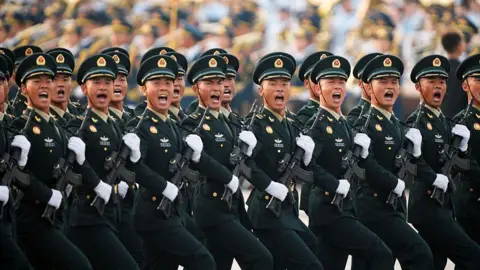Chinese leader Xi Jinping, Russian President Vladimir Putin, and North Korean leader Kim Jong Un stood publicly shoulder to shoulder for the first time on Wednesday, ahead of a massive military parade in central Beijing.
That parade, which marked 80 years since China's victory over Japan in World War Two, saw Beijing unveiling a range of new military hardware – including a new nuclear intercontinental ballistic missile, a new road-bound missile for delivering hypersonic weapons, a new laser weapon, and even 'robotic dog' drones.
It comes at a time when Xi seeks to project Beijing's power on the international stage - not just as the world's second-largest economy but also as a counterweight to the United States as Trump's tariffs rock the global economic and political order.
Five BBC correspondents assess the significance of Wednesday's parade – what it means, why it matters, and what the spectacle tells us about the 'new world order'.
An enduring image for China - and the world
By Laura Bicker, China correspondent
One of the most enduring images of this military parade took place before the first cannon was fired.
President Xi welcoming North Korea's Kim Jong Un with a long handshake before moving on to greet Russia's Vladimir Putin while all three walked together to watch the parade was sheer political theatre.
This was the first time all three leaders have been seen in public together, and they really picked their moment.
But this meeting, rather than the weapons and troops on show, appears to have grabbed the attention of Donald Trump, who posted on Truth Social earlier, accusing Xi of conspiring against America with the others.
Wednesdays parade was a choreographed spectacle of precision, power and patriotism. The troops goose-stepped past in unison, and each strike of the ground echoed through the stands of 50,000 guests in Tiananmen Square. The parade showcased where China is going: Xi playing the role of a global leader prepared to stand alongside two of the most sanctioned leaders in the world.
Trump's out, Xi's in - and what that means for the West
By James Landale, diplomatic correspondent
President Xi has long sought to put himself at the center of a new world order – one that replaces the crumbling global systems established after World War Two.
But two things will send shivers down western diplomatic spines: the speed with which China is filling the vacuum left by America's withdrawal from international norms and institutions, and the formation of a Chinese-led world order.
A clear message to Donald Trump
By Steve Rosenberg, Russia editor
All the diplomacy (and the optics) in China this week was designed to send a clear message to the Trump administration: that an alternative to the US-led order is being offered.
The weapons that worry the West
By Frank Gardiner, security correspondent
China's latest military parade featured massive, underwater torpedoes, state-of-the-art laser weapons and is expected to be analyzed by Pentagon experts and defense officials worldwide. The PLA's extensive modernization program is catching up—sometimes overtaking—the United States, particularly in hypersonic technology. This signals a rapid evolution of military capabilities that challenges Western dominance.




















